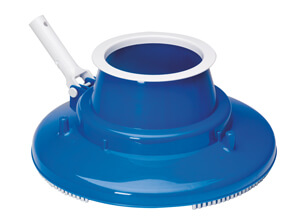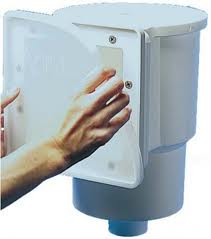First off – I HIGHLY RECOMMEND that you don’t close your own pool! This is a process left best to professionals. Here is the best way to close a pool – http://www.performancepools.com/schedule.html
With that said, here are a few tips to make the closing better.
Leaks:
In ground pools can sometimes be susceptible to leaks, and a leak during winter can cause problems, so first and foremost – find any fix any suspected leaks in the shell of the pool. A leak in the skimmer may not pose a problem, but a leak in the pool light, main drain or a rip in a vinyl liner can remove the supporting water level your pool cover needs.
Without the weight of the water in the pool, serious structural problems can occur for a pool that drains out during winter. So, if you have suspected a leak, do your best to find and fix it, or monitor the water level under the cover weekly throughout the winter.
Water Treatment:
I have heard some people shut off the filter, a week or two before closing – Don’t do this! You should keep your pool clean and your pool water treated and balanced until the day you are ready to close your pool. Ideally speaking, your pool water should be at the following levels before pool closing:
pH: 7.2 – 7.6
Alkalinity: 80 – 120 ppm
Calcium Hardness: 180 – 220 ppm
After balancing the water, and a few days before closing is a good time to shock your pool with a chlorine or non-chlorine shock to oxidize any contaminants that may have escaped your normal sanitation routine.
Pool Cleaning:
It is necessary to clean your pool before you are ready  to close it for the winter season. You will have to vacuum the floor, brush the walls, and skim the surface. If you are buried in leaves, you may need the Leaf Eater to help get every last one, before you can begin to close the pool.
to close it for the winter season. You will have to vacuum the floor, brush the walls, and skim the surface. If you are buried in leaves, you may need the Leaf Eater to help get every last one, before you can begin to close the pool.
If you close the pool with algae, dirt or debris still inside, your winter chemicals become overburdened, and you have a real mess on your hands come spring time. It’s always best to deal with any water problems before you close the pool for the winter.
Pool Water Level:
Lower the pool to the level recommended by our service department.
Our next step is to lower the water level below the mouth of  the skimmer to allow the skimmer to drain completely. Vinyl pools can install a skimmer closure like Aquador for in-ground pools and keep the water higher. For those using a Gizmo or winter plugs for the skimmer you will lower the pool water level further.
the skimmer to allow the skimmer to drain completely. Vinyl pools can install a skimmer closure like Aquador for in-ground pools and keep the water higher. For those using a Gizmo or winter plugs for the skimmer you will lower the pool water level further.
Lower the water 3-4″ below the skimmer for solid pool covers, and for mesh safety covers, lower it 12″ below the skimmer. For sand and D.E. pool filters, you can use the backwash line to lower your pool water. Close the skimmer valves or plug the skimmers, to continue pumping below the skimmer level using the main drain line. Cartridge filtered pools may have a drain attachment attached to the pressure side of the pool, if not, a small submersible pump or gravity siphon can be used to lower the water level.
Be ready to work fast after lowering the water level to complete the closing and cover the pool as quickly as possible. If lowering the water cannot be accomplished in a short timeframe, it may be best to cover the pool loosely after cleaning, to keep it clean while the water is lowered.
Pool Filter:
It is very important to clean your filter before you close your pool for winter. If you have a cartridge type filter, remove the unit and clean it thoroughly before placing it back in the tank for winter storage. If you have a sand filter, you should backwash at least twice as long as you normally would.
Pool closing time is a good time to use a pool filter cleanerchemical to remove built up grease, oils and minerals. If left to sit on your cartridges or DE grids, they can develop into harder, more difficult to remove deposits over the winter.
Pool Heater:
For Gas Heaters, turn off any gas valves and electricity to the heater, and remove the drain plugs on both sides. Heat pumps should be powered down, and if there are no drain plugs, loosen the unions and tip the unit slightly to drain. Most solar heaters have a means to allow for complete drain down, remove any plugs installed to drain the panels.
Plumbing and Piping:
It is imperative that your pool plumbing and all underground lines are blown or drained out in order to prevent any damage that could be caused by freezing water.
THIS is where it is best to leave it to the professionals. Pool line freezes can be very expensive.
Pool blowers can be attached to the skimmer, and push air through the skimmer line, through the equipment with drain plugs removed, and back through the return lines. While the returns are bubbling, you plug these lines at the pool. Turn a few valves and you can blow out other skimmers and main drain lines, fountains or pool cleaner lines.
You can also use a non-toxic antifreeze to prevent freezing in pipes. This can be used as an alternative, in some cases, to blowing out pipes or just as added insurance against freeze damage. Not recommended for use in your pool equipment; like pumps, filters, heaters or chlorinators.
Equipment Care:
Drain all pumping, filtering, heating and chlorinating equipment and for extra assurance. Each piece of equipment should have a drain plug, and some systems have plugs drilled into low spots in above ground piping.
Closing is also a good time to lubricate the o-rings on your pool pump and filter, valves, plugs, and threads. Use a Teflon based lubricant.
Ladders and Accessories:
Remove the pool ladder by pulling up on the escutcheon plate and loosening the anchor bolt. After the bolt rises up 1-2 cm, tap it down with a small hammer, to loosen the anchor wedge.
Other items to remove include hand rails, skimmer baskets, wall fittings, fill spouts, solar blankets, pool cleaners. Store inside if possible, or if not, in a dry, protected area.
Winter Chemicals:
Algaecides and winter chemicals will keep your pool water clean while thepool is not in use and prevent the growth of algae and bacteria. Use our PLATINUM Winterizing Chemical Kit and follow our easy instructions.
These kits are pre-measured based on your pool size so they take the guesswork out of how much chemicals to add.
Pool Cover:
Covering your pool is very important to prevent debris and sunlight, which in the absence of filtration, allows algae to grow and thrive. Pool covers come in solid or mesh types.
Safety covers are held in place by brass anchors inserted  into the deck, solid pool covers use water bags or Aqua Blocks to hold them in place. If you need extras, we have plenty on hand!
into the deck, solid pool covers use water bags or Aqua Blocks to hold them in place. If you need extras, we have plenty on hand!
Your pool cover should fit tightly to prevent any debris from blowing under the cover and into the pool.
Pool Cover Pump:
Unless you are using a mesh pool cover, rain water will accumulate on top of your pool cover. Use a pool cover pump to remove standing water from the surface of a solid pool cover.
Pool cover pumps are usually electric powered and come with a long cord. Connect the pump to a garden hose, place onto the cover and plug it in! Pool cover pumps differ in the Gallons Per Hour (GPH) of water they can pump. Two of our biggest selling cover pumps are the Rule 1800 Pool Cover Pump and the Little Giant Water Wizard Pump.
and again – I HIGHLY RECOMMEND that you don’t close your own pool! This is a process left best to professionals. Here is the best way to close a pool – http://www.performancepools.com/schedule.html























